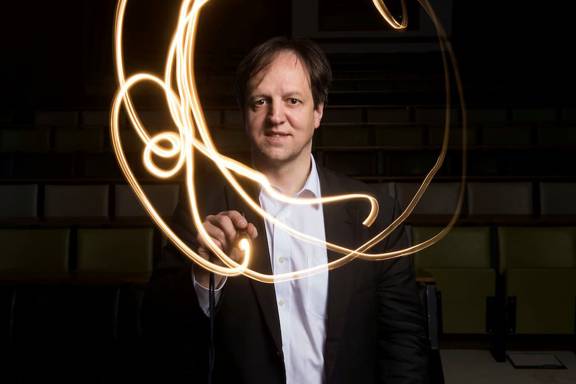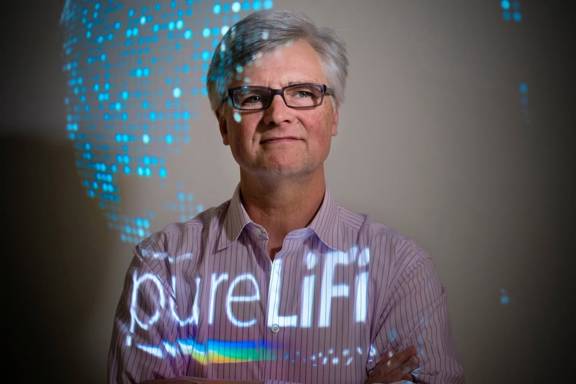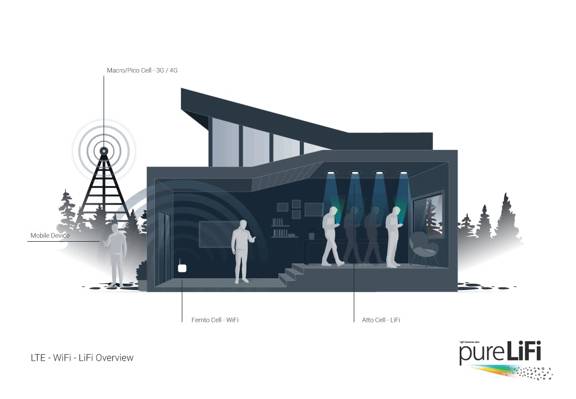How pureLiFi is redefining technology
16 Oct 2019 • 4 minute read
Established in 2012, pureLiFi is a spinout from the University of Edinburgh

One of Scotland's most promising tech firms, pureLiFi is blazing a trail globally with a new method of wireless LiFi communication that will change how we access the internet.
Think faster communications
Think of a world where every light could connect you to the internet. The lights that illuminate our offices, homes, cars and streets connecting us to high-speed, secure data – and to each other. This is what LiFi does.
The term LiFi, or light fidelity, was coined by pureLiFi co-founder Professor Harald Haas (pictured) when he demonstrated LiFi for the first time at a LiFi TED Global talkopens in a new window in 2011.
Since Professor Haas's LiFi TED Global talk, wireless communications industries have started to realise they're facing a real challenge.

The world is consuming 60% more wireless data every year. Radio frequencies used for technologies such as WiFi cannot sustain this level of growth. We're quickly facing a spectrum crunch. LiFi can open 1,000 times more spectrum, and help not only alleviate the crunch, but unleash unprecedented data and bandwidth.
Established in 2012, pureLiFi is a spinout from the University of Edinburgh and has been creating a buzz globally ever since, including being named named Scotland's most innovative companyopens in a new window in 2020 by Business Cloud.
pureLiFi is now among major companies operating in the global LiFi market – a market forecast to be worth around $275 million USD by 2025 (growing at a CAGR of 31.5% from 2020-2025). Source: IndustryARCopens in a new window
How does LiFi work?
LiFi is bidirectional, full duplex (data can transmitted in two directions at the same time) and fully networked wireless communications using LED lights. It repurposes the same light we use to illuminate our homes, offices and streets to provide high-speed, secure wireless communications.
With LiFi, data is transmitted by altering the intensity of the light, which is then received by a photo-sensitive detector, and the light signal is transformed into digital form. Data is then transmitted back to the access point in the ceiling, allowing for fast, full-duplex communications.
Additional benefits for LiFi technology
Security
Light can be contained. Light cannot travel through walls, which means a LiFi signal can be secured in a physical space. pureLiFi’s technology also enables additional control as data can be directed from one device to another. Users can see where data is going, so there is less need for additional security.
No interference
Radio frequency technologies such as WiFi are vulnerable to interference from a wide range of devices such as cordless phones, microwaves and nearby WiFi networks. LiFi signals can be defined by area of illumination, which means interference is much simpler to avoid and even stop all together. This also means LiFi can be used in areas where you can’t use radio frequency technologies, such as hospitals, power plants and airplanes.
Data density
Data density offers a greater user experience as it reduces the need to share the wireless bandwidth with other users. LiFi can achieve around 1,000 times the data density of WiFi, offering more data per square metre. This is an important factor for wireless efficiency.
Efficiency
LiFi allows the repurposing of light for communications as it uses the same infrastructure. LED lights are already efficient, and the visible light spectrum is plentiful, unlicensed and free to use.
Smart lighting
Any private or public lighting including street lamps can be used to provide LiFi hotspots. The same communications infrastructure can be used to monitor and control lighting and data.
Location services
LiFi systems are fully networked and each LiFi enabled light has its own IP address. This means advanced geo-fencing can be set up simply in a LiFi network.
A supportive environment in Scotland
As a university spinout, pureLiFi has found that the innovative research and development taking place at Scottish universities, including the University of Edinburgh, Strathclyde, Heriot-Watt, St Andrews, and Glasgow, provides them with the expertise that they need.
According to pureLiFi’s CEO, Alistair Banham, "LiFi could introduce a new paradigm in the battle to find new bandwidth to cope with rising numbers of devices that connect wirelessly to the internet."

Alistair Banham, CEO of pureLiFi

A simple explanation of how pureLiFi's technology works
"Scottish Development International has provided invaluable assistance, helping us to access new opportunities such as events like Mobile World Congress and new contacts beyond our borders," Alistair added.
pureLiFi has since teamed up with communications and lighting leaders to form a global association called the Light Communications Alliance (LCA)opens in a new window. The LCA will work on developing and refining the key use cases and deployment applications, as well as advocate the use of standards for this emerging industry.
You might also be interested in
-
Edinburgh's thriving tech scene
-
Digital skills support
Discover how Scotland's digital talent is benefiting businesses around the world and how Skills Development Scotland can help you access that talent.
-
Scotland's IoT network
Get the latest updates from Scotland
Questions about trade with or investment in Scotland?
We’re always ready to help. Send us an enquiry, or give us a call.
